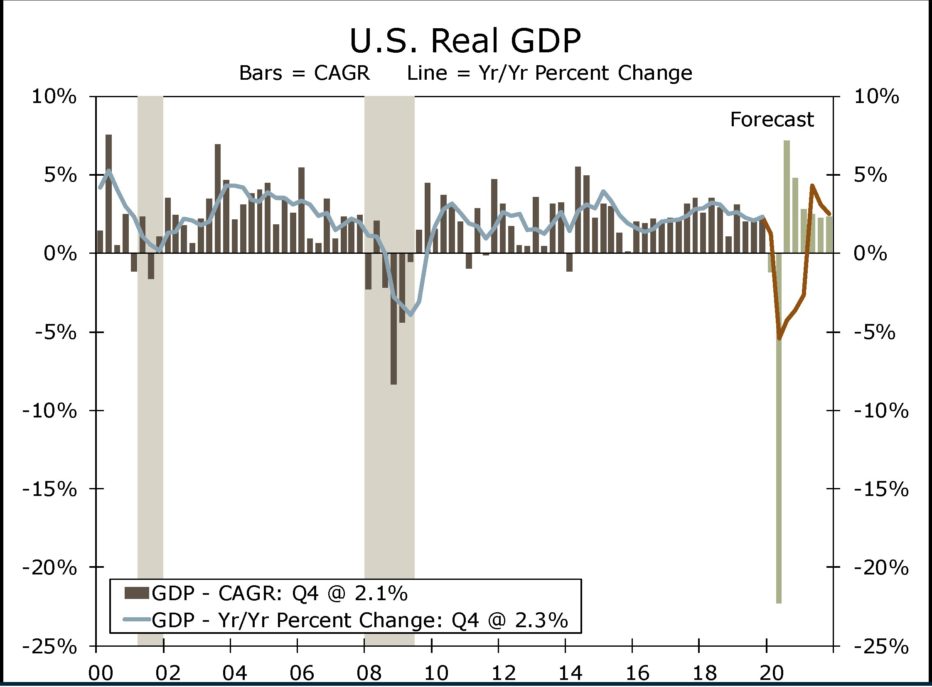We are apparently expected to name our economic events. The title above is one I’m seeing increasingly as the reference to the recession we are now experiencing. This past week marked the first month of sheltering at home in PA, and for most of the U.S. Today, the Labor Department reported that 5.2 million more Americans filed for unemployment last week. That brings the total for the four weeks to more than 22 million people laid off. It’s likely that number will be added to significantly next week but many economists believe that the terrible total from the first four weeks will have brought the U.S. economy very close to the bottom of the cycle. Allowing for the few companies that were hiring during April, the next jobs report on May 1 should show unemployment above 17%.
It’s way too soon to have a clear idea of what the recovery from this looks like. First, we’d have to have a clear end to the pandemic. In the U.S., there are insufficient means to test and trace those who are infected, meaning that the methods used to return to normal in other countries that have beaten back COVID-19 can’t be applied here yet. Assuming that business does begin to re-boot sometime in May, here are a couple of thoughts about what to expect from various economists and researchers:

1: Reopening the economy in the manner suggested by the advisors to the White House would lead to about one-third of the unemployed to rejoin the workforce by July. That brings unemployment back to 13% or so.
2: The abrupt nature of the disruption probably dipped GDP into negative territory for the first quarter. The deep decline since late March should compress most of the technical recession into the second quarter. That dip will be catastrophic, likely above 20%.
3: GDP growth should return in the third quarter. Some very smart economists predict that GDP will bounce back 7-10% this summer. I’m not sure I buy that but I understand upon what those experts base their forecast.
4: Without adequate testing and tracing, COVID-19 infections will flare up in the fall (maybe even sooner in places that have ignored the advice to practice social distancing). Controlling those flare-ups of community spread will allow the recovery to continue.
5: “Normal” will not return again until there is a widely available, affordable, treatment for COVID-19. That can either be a therapy or a vaccine.
The discussions/shouting match about reopening the economy is political, not economic. Neither the president, nor Congress, nor governor, nor mayor can get people back into restaurants, shopping centers, and offices if they don’t trust the environment will be safe for them. It’s why the success of finding a therapy or vaccine is not just a medical necessity but also an economic necessity. If we can take an antibiotic, or gargle with Listerine, or get a shot, and be confident that it won’t kill us, we’ll begin to return to our old habits of consumption. That’s when the economy will grow fast enough to bring everyone back to work.
One surprising finding from talking to local contractors this past week: bidding didn’t really slow down over the past month. Most of the public bidding did; however, owners as varied as PNC, Hitchiker Brewing, Chase Bank, Walnut Capital, Dancing Gnome, and Pitt have taken bids and awarded contracts while we have been sheltering. These haven’t turned into construction starts yet but it suggests that some number of the owners are ready to renew their business when it is safe to do so.
In construction news, the $40 million CCAC Workforce Development Center is out to bid. Likewise, bids are being taken for the $20 million Arnold Palmer Airport Runway Expansion and the $15 million Montgomery Dam repairs near Monaca. Pittsburgh’s URA approved financing for several projects this week. Mistick Construction will be renovating 327 North Negley into apartments, a $10.7 million project. URA approved funding for the $27 million Flats on Forward in Squirrel Hill, which PJ Dick will build. Buccini/Pollin and the Penguins unveiled its plans to the URA for purchasing the site for the $200 million FNB Tower in the Lower Hill. That project will be built by a venture involving PJ Dick, Mascaro and Massaro.
